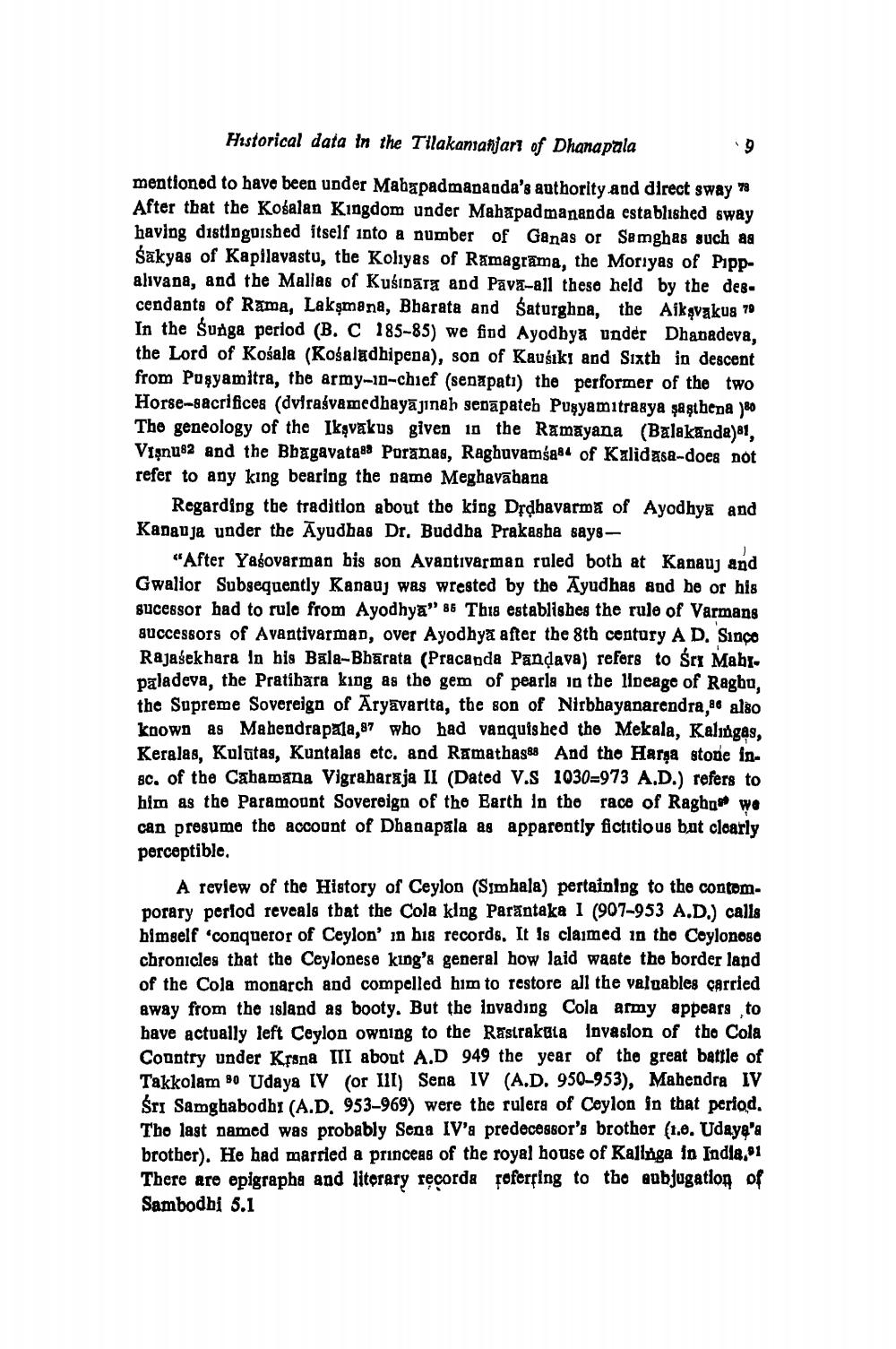________________
Historical data in the Tilakanaħjart of Dhanapala
mentionod to have been under Mabapadmananda's authority and direct sway * After that the Košalan Kingdom under Mahapadmananda established sway having distinguished itself into a number of Ganas or Samghas such as Śakyas of Kapilavastu, the Kolyas of Ramagrāma, the Moriyas of Pippalivana, and the Mallas of Kuśpāra and Pava-all these held by the des. cendants of Rama, Lakşmana, Bharata and Saturghna, the Aikşvakus 79 In the Sunga period (B. C 185-85) we find Ayodhya under Dhapadeva, the Lord of Košala (Košaludipena), son of Kausiki and Sixth in descent from Poşyamitra, the army-in-chief (senapatı) the performer of the two Horse-sacrifices (dvirasv&medhayājinah senapateb Pusyamitrasya şaşthena 180 The geneology of the Ikşvakus given in the Ramayana (Balakanda)81, Vişnu82 and the Bhagavataa8 Poranaa, Raghuvamsast of Kalidasa-does not refer to any king bearing the name Meghavahana
Regarding the tradition about the king Drdbavarma of Ayodhya and Kanalja under the Āyudhas Dr, Buddha Prakasha says
"After Yagovarman bis son Avantivarman ruled both at Kanauj and Gwalior Subsequently Kanauj was wrested by the Ayudhas and he or his sucessor had to rule from Ayodhya" 86 This establishes the rule of Varmans guccessors of Avantivarman, over Ayodhya after the 8th century A D. Sinco Rajasekhara in bis Bala-Bharata (Pracapda Pandava) refers to śry Mahipaladeva, the Pratibara king as the gem of pearla in the lloeage of Raghu, the Supreme Sovereign of Aryavartta, the son of Nirbhayanarendra as algo known as Mahendrapala,87 who had vanquished the Mekala, Kalingas, Keralas, Kulutas, Kuntalas etc. and Ramathas88 And the Harşa stone insc. of the Cahamana Vigraharaja II (Dated v.s 1030=973 A.D.) refers to him as the Paramount Sovereign of the Earth in the race of Raghoe we can presume the account of Dhanapala as apparently fictitious but cloarly perceptible,
A review of the History of Ceylon (Simhala) pertaining to the contomporary period reveals that the Cola klng Parantaka I (907-953 A.D.) calls himself 'conqueror of Ceylon' in bis records. It is claimed in the Ceylonogo chronicles that the Ceylonese king's general how laid waste the border land of the Cola monarch and compelled him to restore all the valuables carried away from the island as booty. But the lovading Cola army appears to have actually left Ceylon owning to the Rastrakula Invasion of the Cola Country under Krona III about A.D 949 the year of the great battle of Takkolam 80 Udaya IV (or Ill) Sena IV (A.D. 950-953), Mahendra IV Sri Samghabodhi (A.D. 953–969) were the rulera of Ceylon in that period. Tho last named was probably Sena IV'a predecessor's brother (1.0. Udaya'a brother). He had married a princeas of the royal house of Kalinga in India,91 There are epigrapha and literary recorda foferring to the aubjugation of Sambodhi 5.1




